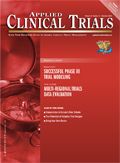Device Independence is the Future of Clinical Trials
Applied Clinical Trials
Bring Your Own Device (BYOD) makes sense economically and socially and is the future of clinical trials.
It is said that the world is getting smaller. A notion that is due to the on-going advances in technology; not just in capability but also in accessibility. Statistics show that there are now over six billion mobile phone subscriptions world-wide and it is this availability and familiarity with technology that has led to an opportunity for the use of a patient's own device in global clinical trials. In turn, this could reduce the need for costly device provision; a model known as: bring your own device (BYOD).

The rise of BYOD has been remarkable. Some 53% of organizations now let users connect their device to a corporate network. I find this number staggering when you consider the implications of letting employees store confidential information on their personal smartphones, laptop computers, or tablets, and this concern for personally identifiable information is one reason why many working in the healthcare sector believed that BYOD would never transfer successfully to the clinical trial arena when trying to engage patients and capture their data. They have, however, been proved wrong.
In the past, ePRO data has been captured by provisioning devices, using fixed parameters for data viewing and validation. This has historically brought its own restrictions requiring specific devices regardless of the user population. The use of BYOD or device independent technology has opened up the possibilities of provisioning through the ability to recognize device parameters and optimize the configuration of data according to the device in use. This offers the flexibility to select the provisioned device according to specific populations, as well as ensuring instruments are displayed within validation requirements. Personally identifiable information can be extracted so that specific health information is not linked to an identifiable individual unless the viewer, for example the HCP, has authorization. It also enables physical separation of data in order to comply with local data protection laws.
Additionally, a device independent approach allows the flexibility to select and provide the most appropriate device for a patient demographic where provisioned devices are preferred. However, the ability to run device diagnostics and identify the specific device in use by each patient opens up the opportunity to significantly reduce and even remove the need for provisioning entirely. Device analysis can easily be integrated into patient enrollment and provisioning can typically be reduced to as little as 10% or 20% of study participants. In some cases the need for provisioning can be removed altogether and the participants' own devices can be employed throughout the study.
BYOD in clinical trials isn't a concept of the future; it's happening now. For example in large population, multi-country late phase studies the BYOD model has enabled cost-effective deployment of electronic patient communication and data capture. Global cardiovascular outcomes studies have seen an emergence of BYOD, while other studies using a part provisioning model can check a device, then only provision locally when necessary—saving time and money.
By reducing the cost of full-scale provisioning and significantly reducing the logistical challenge of managing and maintaining large quantities of devices across the globe, a device independent approach delivers an extremely cost effective patient-centric strategy for sponsors, CROs and payers, that both enhances patient engagement and addresses data capture requirements. The train has left the station as far as BYOD use in clinical trials is concerned, and it is for these reasons that device independence makes sense economically and socially and is the future of clinical trials.
Tim Davis CEO and Co-Founder Exco InTouch E-mail: [email protected]
